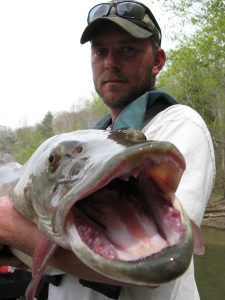
Photo: KDF
Spring break for many conjures thoughts of traveling somewhere warm and catnapping on a beach between rounds of golf.
A staycation sounds much better if you’re a muskellunge angler from Kentucky. The state’s muskellunge fishery has earned a reputation that extends beyond its borders, and experienced anglers know spring is one of the can’t-miss times of the year.
“Your odds of catching a trophy are better in the spring and fall,” said Tom Timmermann, northeastern fisheries district biologist for the Kentucky Department of Fish and Wildlife Resources. “In the fall, they’re packing on that weight to get through the winter. In the spring, if you catch those females before they release their eggs, they’re full of eggs. Either way, you’re looking at a chance at some bigger fish.”
Kentucky lies within the natural range of the Ohio strain of muskie, but the population in lakes and streams now is supported with stocking.
The bloodlines of these young predators trace to broodstock collected each spring from the Licking River. Kentucky Fish and Wildlife’s Minor Clark Fish Hatchery at the foot of Cave Run Lake Dam raises every muskellunge stocked in Kentucky.
Buckhorn, Cave Run, Dewey and Green River lakes are managed as trophy fisheries and there is a 36-inch minimum size limit in place on each. A 30-inch size limit for muskellunge is in effect elsewhere in the state
Cave Run Lake reaches into parts of Bath, Menifee, Morgan and Rowan counties and it produced the current state record in 2008. The 47-pound bruiser measured 54 inches.
Mike Hardin grew up fishing the lake and this past fall released a 50-incher caught on a homemade inline spinner.
“I believe they’re probably right there and ready to go pretty soon,” said Hardin, an assistant fisheries division director with Kentucky Fish and Wildlife. “The cold weather may slow things down a little bit but they’re already making that march.”
The longer periods of daylight and water temperatures climbing past 50 degrees trigger the muskellunge’s instincts to move shallow. Many anglers do well focusing on larger embayments, secondary cuts and flats because they warm up first.
Look for areas that offer food, vegetation or timber, warmer water and close proximity to deeper water. Scotts Creek, Warix Run, Buck Creek and Leatherwood on Cave Run Lake are popular spots in spring. Start at the points and work back to the shallows, casting to the bank and any structure or sub-surface features along the way.
“Those fish run up into the hollows seeking that flowing water,” Timmermann said. “The males are up there early and the females come up second. If you see a bunch of males, you know you’re still a little ways off from the big fish getting up there.”
Kentucky Fish and Wildlife is studying the impact of a 2010 regulation change that adjusted the size limits on Buckhorn, Cave Run and Green River lakes to 36 inches.
The same size limit went into effect last year on Dewey Lake in Floyd County. It is maturing as a muskie fishery after receiving its first muskie stocking in 2014. Sampling conducted this past fall found some of those fish had reached the minimum size limit.
At Buckhorn Lake in Leslie and Perry counties, catch rates have been better in the lower lake due to the habitat. “We have some larger shallow flats and there’s a lot of woody debris on those,” Kentucky Fish and Wildlife fisheries biologist Joseph Zimmerman said.
At Green River Lake in Adair and Taylor counties, the areas around the Emerald Isle and state marinas produce some of the better catch rates on the lake while the upper reaches of the Robinson Creek, Casey Creek and Green River arms offer large shallow flats worth exploring.
“The area behind the state marina is a good spot,” said Eric Cummins, southwestern fisheries district biologist with Kentucky Fish and Wildlife. “It’s wind protected and heats up quicker than some other parts of the lake.
“In the upper ends of the lake, you have warmer water dumping in at the mouths of those feeder creeks. If you have some stained water, muskie will slide up a little shallower and generally be more available to your shallower presentations.”
Many a bass angler pitching a crankbait or plastic frog has been surprised by a muskie. To have a fighting chance, it’s best to pair a 6-foot-6 or longer medium-heavy or heavy action rod with a 4.2:1 or 5.2:1 ratio baitcasting reel spooled with 65-pound or heavier braid. Wire leaders of 9- to 18-inches are a necessity because of the muskie’s sharp teeth.
Up-sized rattling lipless crankbaits, large soft-plastic swimbaits, minnow-imitating crankbaits, jerk and glide baits, spinnerbaits and in-line spinners are enough to cover just about any situation in the spring.
Anglers should dip the rod tip into the water as a lure gets to within a few feet of the boat and draw a figure eight. Muskie are prone to stalk a lure and the figure eight can entice a boat-side strike.
“I don’t know how many fish I’ve had hit right at the boat and I’ve never seen them until I’ve made the turn,” Hardin said.
A guide once told Timmermann that muskellunge anglers should not be married to one spot in spring.
“If you’re not catching fish, if you’re not seeing fish on your electronics, if you’re not raising fish, keep moving,” Timmermann said. “This time of year, jump from big hollow to big hollow.”
On Cave Run and Dewey lakes, anglers should inspect their boats and lures and discard any weeds before running to a new spot because of the presence of hydrilla, an invasive aquatic plant. Hydrilla was discovered just last year in Cave Run Lake.
“This is not a good thing for the lake,” Timmermann said. “Pay attention to what you’re moving and when you’re moving it. Clean your motors and trolling motors off before you move to a new spot and clean those weeds off of your baits.”
Furthermore, boaters can fight the spread of hydrilla by clearing any plant material from their boats before launching and removing all plant material from boats, motors and trailers after pulling their boats from the water. Spray or scrub off any remnants of plant material on boats before storing them.
One more thing to remember before trying for the muskellunge of a lifetime this spring in Kentucky is a fishing license. The new license year started March 1. Consult the Kentucky Fish and Boating Guide for complete licensing information. It is available online at fw.ky.gov and wherever licenses are sold.
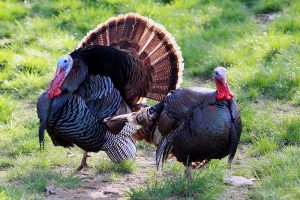
Photo From KDF
Spring turkey hunting is slipping into position before daybreak and sitting still as the sun eases over the hills.
It is breaking the silence with a call and getting a response that sends a shock of excitement down your spine. It is coaxing a love-struck gobbler closer and keeping your wits as it struts into range.
“There’s something about that drumming, spitting, gobbling turkey in front of you that makes the ground shake,” said Jason Lupardus, Midwest Conservation Field Supervisor with the National Wild Turkey Federation who has regional biologist duties in Kentucky. “I live for those moments. Favorite time of year, by far. You can’t beat it.”
The spring turkey season is something of an obsession among hunters who have experienced those magical mornings many times over or dream about it happening their first time out this year.
In Kentucky, the 2017 season is right around the corner. Hunters ages 15 and younger are first up. The youth-only season is the weekend of April 1-2. The general statewide season opens April 15 and runs through May 7.
“I’ve got high hopes,” said Zak Danks, wild turkey program coordinator with the Kentucky Department of Fish and Wildlife Resources.
The state’s turkey flock numbered fewer than 2,400 birds when restoration efforts began in 1978. The restoration continued until 1997, and today turkeys can be found in all 120 counties. The statewide turkey flock is estimated from 200,000 to 240,000.
Kentucky Fish and Wildlife monitors turkey reproduction through annual brood surveys conducted every summer.
A wet spring and early summer affected nest success and brood survival in 2016. The number of turkey poults per hen averaged 1.6 across the state, down from 2.3 the year before. What that means for this spring is fewer jakes but a strong crop of older, more experienced gobblers.
“We should have plenty of 2-year-old birds out there gobbling and providing good opportunity for folks,” Danks said. “I’m pretty excited about it. Of course, we’re going to cross our fingers and hope for good weather. The early season weather really impacts things. If we get good weather, people will get out and should have some good action.”
Lupardus is even more bullish about the upcoming season.
“We may have our banner year,” he said. “There were reports last spring of lots of jakes running around. That tells me that banner production from two years ago was still in place. Therefore, we should have a lot of 2-year-old birds out there gobbling this year. I’m thinking this could be our 10-year high.”
Kentucky’s spring turkey harvest has remained stable since the 2010 season when hunters took a record 36,097 birds.
The average spring harvest for the six years before 2010 was 26,887. In the six years since, the average spring harvest was 31,600. Hunters checked 31,047 birds last spring.
Kentucky times its spring season to give gobblers ample opportunity to breed hens before subjecting them to hunting pressure. The mild winter and subsequent early green up this year has ramped up anticipation.
“I’m sure people have been seeing a lot of birds strutting, hearing some gobbling, and that may have them wondering why we don’t start hunting them sooner like some other states,” Danks said. “But we really feel like we have a good handle on our season. We’re trying to strike a balance between hunting opportunity and protecting the resources.”
A strong mast crop this past fall combined with the mild winter should translate into hens being in tip-top physical condition for the breeding season.
“Which hopefully could bode well for their clutch sizes,” Danks said. “When hens are in better condition, they lay better eggs with more yolk reserves and hopefully that leads to better poults. We would like to think that we’re coming into a really good spring in that respect.”
Hunters are allowed a limit of two bearded birds during the spring season. Any combination of male turkeys, or female turkeys with visible beards, may be included in the season limit. No more than one bird may be taken per day.
Shooting hours are 30 minutes before sunrise to 30 minutes after sunset, but hunters may be in the field before and after shooting hours.
While many hunters focus their efforts on the early season and early morning hours, Bo Spencer does not overlook the mid-morning and late-season opportunities.
“I tend to really like mid to late mornings and the second half of our spring season,” said Spencer, who works in Kentucky Fish and Wildlife’s Information Center and is an avid turkey hunter. “The first week or two of the spring season, hens are roosting with and staying with gobblers until mid-morning. After about 9:30 or so, the hens have left the gobblers. Often times this will result in a gobbler becoming more willing to answer and come to calls.”
He continued: “The second half of our spring season, hens are on the nest and those gobblers are still in breeding mode. Late-season birds can be more willing to work to calls. They might not be as vocal and gobble as much as pre-season and early season but they will come looking. These late-season birds can come in quietly and all of the sudden there is a gobbler in range that you didn’t know was even in the area.”
Hunters are encouraged to consult the 2017 Kentucky Spring Hunting Guide before the season or going afield. The guide provides information about current regulations, licenses and permits, legal equipment, safety tips and more. It is available online at fw.ky.gov and wherever licenses are sold.
Kentucky Fish and Wildlife helps take the worry out of finding a place to hunt. It owns, leases or manages more than 80 public hunting areas across the state, and all but a few are open under statewide hunting regulations for the spring turkey season. These exceptions are noted in the guide. A complete listing of public hunting areas can be found on the department’s website.
Be sure to tune in to Kentucky Educational Television (KET) on Saturday, March 25 for a special “Kentucky Afield” TV half-hour call-in show focusing on the spring turkey season. The live show airs at 8:30 p.m. Eastern/7:30 p.m. Central.
Danks and a representative from Kentucky Fish and Wildlife’s Law Enforcement Division will join host Chad Miles to field phone calls from hunters across the state.
Race Expo Temporarily Moves to Kentucky Exposition Center
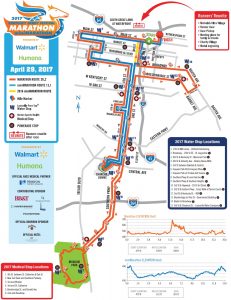 The Kentucky Derby Festival is re-routing a small portion of the 2017 Kentucky Derby Festival Marathon/miniMarathon presented by Walmart and Humana due to the renovation of the Kentucky International Convention Center (KICC). The races are set for Saturday, April 29. The courses for both the miniMarathon and Marathon will be diverted one block to Second Street. This will affect the half marathon between mile 12 and 13; and the full marathon at mile 25. Marathon runners will also notice small changes between mile 13 and 14, to make up some additional distance. Overall, the changes affect less than one mile of the entire race.
The Kentucky Derby Festival is re-routing a small portion of the 2017 Kentucky Derby Festival Marathon/miniMarathon presented by Walmart and Humana due to the renovation of the Kentucky International Convention Center (KICC). The races are set for Saturday, April 29. The courses for both the miniMarathon and Marathon will be diverted one block to Second Street. This will affect the half marathon between mile 12 and 13; and the full marathon at mile 25. Marathon runners will also notice small changes between mile 13 and 14, to make up some additional distance. Overall, the changes affect less than one mile of the entire race.
“All downtown traffic is being rerouted to avoid the construction and the Kentucky Derby Festival is no exception,” said Matt Gibson, Senior Vice President of Events for the Kentucky Derby Festival. “Fortunately these are minor changes and will have minimal impact on the runners’ experience.”
The Festival is working with Louisville Metro Police to ensure the route is safe for the runners and still accessible to traffic. As they do along the entire race route, LMPD will assist with vehicle cross traffic at intersections, to ensure residents and businesses can still reach their destination when breaks in the race permit.
Along with changes to the course, the Race Expo will also temporarily move to the West Wing of the Kentucky Exposition Center (KEC) on April 27 and 28, 2017. The Expo is traditionally held at KICC, but will relocate to KEC for both 2017 and 2018, until the renovations are complete. Complimentary shuttles will be provided to transport runners from Downtown to the Kentucky Exposition Center. Parking fees will also be waived for runners picking up their race packets at the Expo. Runners will receive all the details in their confirmation packets and can also find it online at DerbyFestivalMarathon.com.
“We’re partnering with the Kentucky Exposition Center and the Convention & Visitors Bureau to make sure this move is seamless for the runners and our vendors,” said Shanna Ward, Race Director.
Operations, parking and other amenities at the start, finish and along the course remain unchanged. Both races will still start at 7:30 a.m. on Main Street in downtown Louisville and finish at Preston and Witherspoon Streets. The runners will also run through the main gate at Churchill Downs for their lap through the infield.
The Marathon and miniMarathon marks the largest annual day of road racing in Kentucky. Registration is still available online at www.derbyfestivalmarathon.com. Current registration is $85 for the mini and $95 for the Marathon.
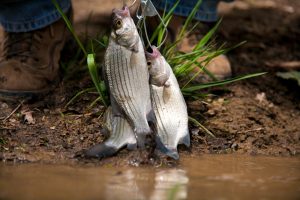
Photo from KDF
February days in the 60s make for crowded boat ramps and golf courses during a time of year usually spent indoors.
Everything, nature wise, seems a couple of weeks ahead of schedule. Buds show on lilac bushes, green grass already grows in bunches and the sound of lawn mowers permeates an afternoon backyard barbecue.
The rare winter temperatures may alter white bass spawning runs as well.
“With the weather pattern so far, I would be looking at the white bass getting going a little earlier than usual,” said Rob Rold, Northwestern Fisheries District biologist for the Kentucky Department of Fish and Wildlife Resources. “When we’ve had consecutive warm days, the white bass run up a bit into the headwaters above Nolin River Lake, but when it cools they go back down in the lake. They will do false runs until it gets right.”
Water temperatures are in the low 50s on Nolin River Lake, while other lakes such as Taylorsville Lake are flirting with water temperatures in the mid 50s.
“It should be getting close,” said David Baker, Central Fisheries District biologist for Kentucky Fish and Wildlife. “We are doing a creel survey on Herrington and the white bass are staging in the upper one-third of the lake, waiting for the next temperature spike. A good warm front with water temperatures getting into the upper 50s, they will start moving to the shoals in the upper lake of both Herrington and Taylorsville.”
Baker said Herrington gets the nod for size of white bass. “There are a lot of really big white bass in Herrington, many up to 14 inches long. For catching a big white bass, Herrington is better than Taylorsville,” he said. Taylorsville Lake produces numbers of white bass, but less size.
Anglers may access the upper section of Herrington Lake and Dix River via Bryants Camp Boat Ramp in Garrard County. Bank anglers may access the Salt River above Taylorsville Lake via River Road on the Taylorsville Lake Wildlife Management Area until the opening of spring turkey season April 15. Boaters use Van Buren Boat Ramp on Taylorsville Lake.
Nolin River Lake holds arguably the best white bass population in Kentucky.
Rold said the Cane Run area, known to locals as the “Three Fingers,” in the upper lake upstream to Broad Ford at the KY 1214 Bridge is usually where the white bass runs begin.
“The length of day really dictates when they will run, even if it is not the preferred water temperature,” Rold said. “They start staging around Cane Run. It is a bit early, but they will come on soon.”
Rold said bank anglers use the access at Bacon Creek for productive white bass fishing. “Go to Bacon Creek ramp and walk the bank up or down,” he said. “The Corps property goes all the way up past Broad Ford. At winter pool, Broad Ford is the first shoal on Nolin River upstream of the lake.”
The tailwaters downstream of the locks and dams on the lower Green River also provide excellent white bass fishing. “The water below Lock and Dam 1 at Spottsville, Lock and Dam 2 at Calhoun and Lock and Dam 3 at Rochester all have decent white bass,” Rold said. “The mouth of Pond River downstream of Calhoun at Jewel City has a big white bass fishery. They run up into Pond River.”
Anglers may access the mouth via a public boat ramp at Jewel City. The tailwater below Lock and Dam 2 has a boat ramp and limited bank access at the end of Second Street in Rumsey, across the river from Calhoun. The tailwaters below Lock and Dam 3 at Rochester offer excellent bank access just west of town on Boat Ramp Road via KY 70.
The smaller male white bass make the initial runs. You will catch many fish during this time, but most will be of similar size. You often catch fish on consecutive casts when the males are running.
“By the first weeks of April, the females show up and it is prime,” Baker said. “This is the best fishing of spring runs.”
Running white bass hit anything that resembles baitfish with abandon, one of the keys to their enduring popularity. When the spring white bass runs peak, nothing else compares to the furious fishing.
White, chartreuse or gray in-line spinners are hard to beat during the runs, but 2-inch white curly tailed grubs rigged on 1/16-ounce leadheads also produce many white bass. Anglers also suspend 1/32-ounce white and red, pink or yellow feather jigs from 18 to 24 inches deep under small bobbers and allow them to drift in the current. Some anglers tip the feather jigs with small crappie minnows to make them more attractive to white bass.
As the runs peak, small topwater propeller baits draw vicious strikes, but you get more consistent action with subsurface presentations.
The next long sustained warm front will get the white bass running. It is time for the most exciting fishing of the year. Remember to buy your fishing license. The new license year began March 1.
“Say Yes To The Dress: Atlanta” Star Will Help Emcee
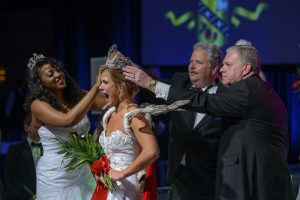 Tickets are available now for the first ball of the Derby season – the annual Fillies Derby Ball hosted at the Louisville Marriot Downtown. This ball is one of the Kentucky Derby Festival’s oldest and most elegant events.
Tickets are available now for the first ball of the Derby season – the annual Fillies Derby Ball hosted at the Louisville Marriot Downtown. This ball is one of the Kentucky Derby Festival’s oldest and most elegant events.
Themed “The Royal Ball,” the event promises to treat every guest like royalty. The event begins at 6:30 p.m. with cocktails, call to the post at 7:15, the Queen’s coronation at 7:30, all followed by dinner at 8:00. For dancing, live musical entertainment will be provided by The Sensations.
The highlight of the Derby Ball – which is planned and produced by The Fillies, Inc. – is the coronation of the Kentucky Derby Festival Queen, selected by the traditional spin-of-the-wheel.
The regal evening will be hosted by Vicki Dortch from WLKY TV with special guest Monte Durham, from TLC’s Say Yes to the Dress: Atlanta. Durham originally joined the Derby Festival in January to help select the five ladies that make up the Royal Court. At the Ball he will return to the festivities to help crown the Queen, along with Kathy Bingham, 2017 Fillies President.
Contributing Sponsors of the event include the Brown-Forman Corporation and Total Wine & More. Media Sponsors are TOPS Louisville and 102.3 The Max.
The Fillies Derby Ball is also the largest fundraiser for the Kentucky Derby Festival Foundation, KDF’s charitable arm. A portion of proceeds from the ball benefits the Foundation.
Tickets are $175 each. VIP tables are also available for $2,500. Tickets include dinner and dancing. For tickets call (502) 572-3856.
 Weather
Weather Traffic
Traffic @LouisvilleDispatch
@LouisvilleDispatch @LouisvilleDisp
@LouisvilleDisp Subscribe
Subscribe